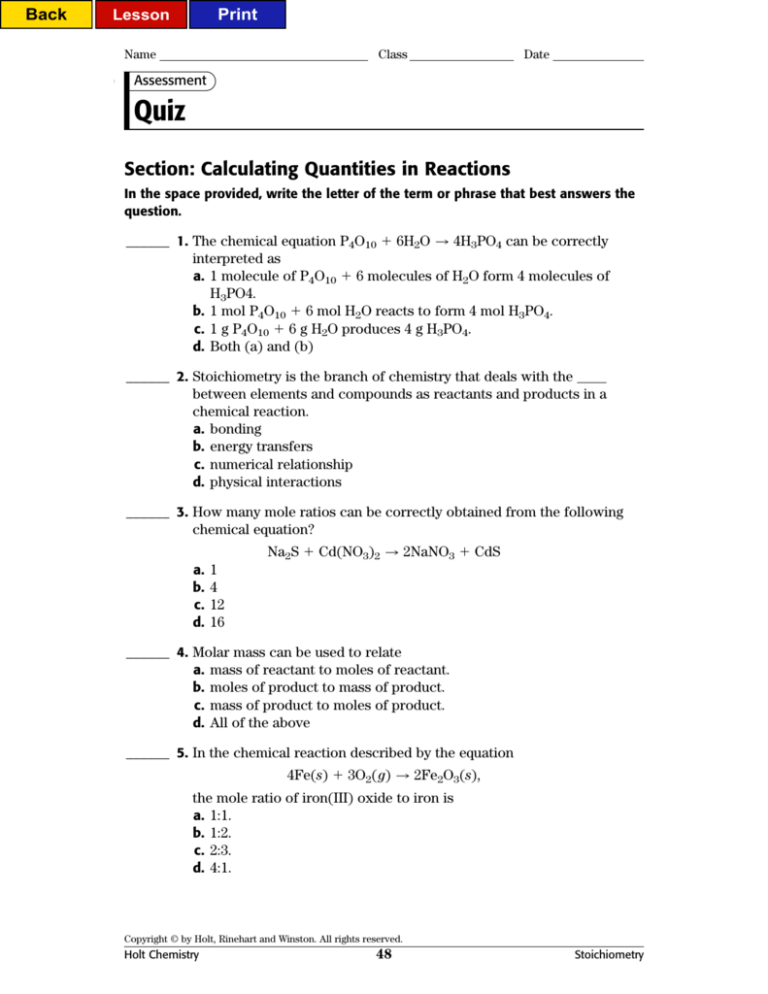
Back
Print
Lesson
Name
Class
Date
Assessment
Quiz
Section: Calculating Quantities in Reactions
In the space provided, write the letter of the term or phrase that best answers the
question.
______ 1. The chemical equation P4O10 6H2O £ 4H3PO4 can be correctly
interpreted as
a. 1 molecule of P4O10 6 molecules of H2O form 4 molecules of
H3PO4.
b. 1 mol P4O10 6 mol H2O reacts to form 4 mol H3PO4.
c. 1 g P4O10 6 g H2O produces 4 g H3PO4.
d. Both (a) and (b)
______ 2. Stoichiometry is the branch of chemistry that deals with the
between elements and compounds as reactants and products in a
chemical reaction.
a. bonding
b. energy transfers
c. numerical relationship
d. physical interactions
______ 3. How many mole ratios can be correctly obtained from the following
chemical equation?
Na2S Cd(NO3)2 £ 2NaNO3 CdS
a.
b.
c.
d.
1
4
12
16
______ 4. Molar mass can be used to relate
a. mass of reactant to moles of reactant.
b. moles of product to mass of product.
c. mass of product to moles of product.
d. All of the above
______ 5. In the chemical reaction described by the equation
4Fe(s) 3O2(g) £ 2Fe2O3(s),
the mole ratio of iron(III) oxide to iron is
a. 1:1.
b. 1:2.
c. 2:3.
d. 4:1.
Copyright © by Holt, Rinehart and Winston. All rights reserved.
Holt Chemistry
48
Stoichiometry
Back
Print
Lesson
Name
Class
Date
Quiz continued
1
______ 6. The expression mass has the unit
molar mass
2
a. mol /g.
b. g/mol2.
c. mol.
d. g.
______ 7. In the chemical equation wA xB £ yC zD, if one knows the mass
of A and the molar masses of A, B, C, and D, one can determine
a. the mass of each reactant and product.
b. the mass of B only.
c. the total mass of C and D only.
d. the total mass of A and B only.
1
______ 8. The expression volume has the unit
molar volume
a. g/L.
c. mol.
b. L.
d. mol/L.
______ 9. What could you use to calculate the volume of ammonia gas produced
by the reaction of 2.0 L of nitrogen gas in excess hydrogen gas at
non-STP conditions according to the chemical equation below?
N2(g) 3H2(g) £ 2NH3(g)
a.
b.
c.
d.
one density, one molar mass, and one mole ratio.
one density, two molar masses, and one mole ratio.
two densities, two molar masses, and one mole ratio.
two densities, two molar masses, and two mole ratios.
______10. If, in the reaction C5H12(l) £ C5H8(l) 2H2(g), 1.50 1022 molecules
of C5H12 decompose, then the following expression
1 mol C5H12
1.50 1022 molecules C5H12 6.022 1023 molecules C5H12
2.02 g H
2 mol H2
2
1 mol H2
1 mol C5H12
calculates the
a. number
b. moles
of H2 molecules produced.
c. mass
d. volume
Copyright © by Holt, Rinehart and Winston. All rights reserved.
Holt Chemistry
49
Stoichiometry
Back
Lesson
Print
TEACHER RESOURCE PAGE
Answer Key
Quiz—Section: Calculating
Quantities in Reactions
1.
2.
3.
4.
5.
d
c
c
d
b
6.
7.
8.
9.
10.
21. Thirty percent of the expected product
is not produced. Therefore, thirty percent of the limiting reactant must be
part of reverse or side reactions.
22. Moles are used because the coefficients in a balanced equation show the
number of moles of reactants and
products in the chemical reaction.
23. The equation does not show other
components of air, such as nitrogen
and organic compounds. It also does
not show impurities in gasoline, such
as compounds of nitrogen and sulfur.
During combustion, these substances
are also oxidized, producing pollutants
such as nitrogen, sulfur oxides, and
hydrocarbons. In addition, the equation does not show that incomplete
combustion can occur, in which case
carbon monoxide is also produced.
1 mol KClO3
24. 100. g KClO3 122.5 g KClO3
74.55 g KCl
2 mol KCl
1 mol KCl
1 mol KClO3
c
a
c
c
c
Quiz—Section: Limiting
Reactants and Percentage
Yield
1.
2.
3.
4.
5.
b
d
c
c
b
6.
7.
8.
9.
10.
c
a
d
d
b
Quiz—Section:
Stoichiometry and Cars
1.
2.
3.
4.
5.
b
c
c
c
c
6.
7.
8.
9.
10.
d
b
a
b
b
11.
12.
13.
14.
15.
16.
17.
18.
19.
20.
d
b
a
d
a
c
c
b
d
a
60.8 g KCl
1.961 g CO
1 L CO2
1 mol CO2
1 mol MgCO
3
44.01 g CO2
1 mol CO2
84.31 g MgCO
3 244 g MgCO3
1 mol MgCO3
25. 65.0 L CO2 2
Chapter Test
1.
2.
3.
4.
5.
6.
7.
8.
9.
10.
d
d
b
d
a
c
b
a
a
a
Copyright © by Holt, Rinehart and Winston. All rights reserved.
Holt Chemistry
90
Stoichiometry








